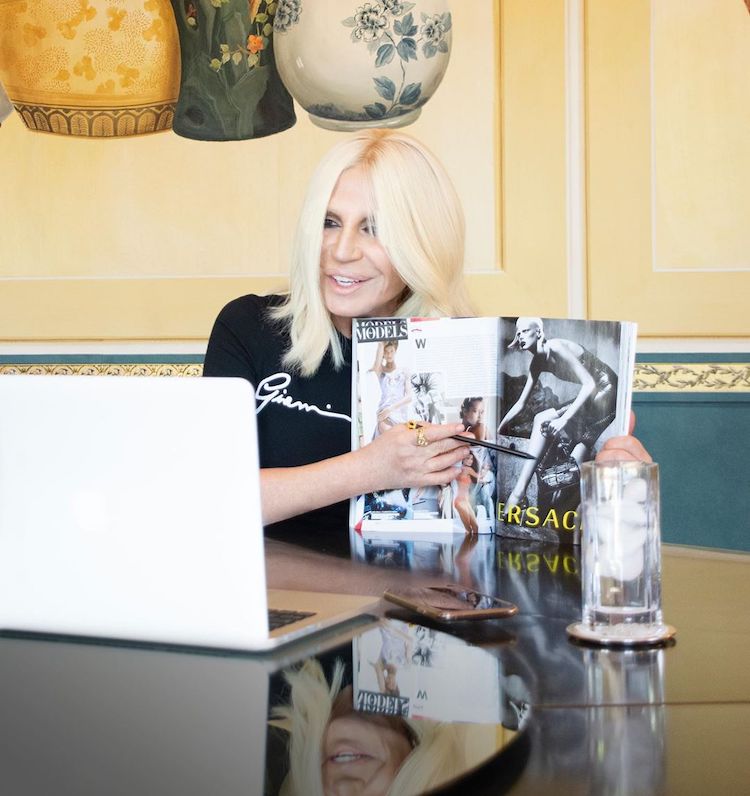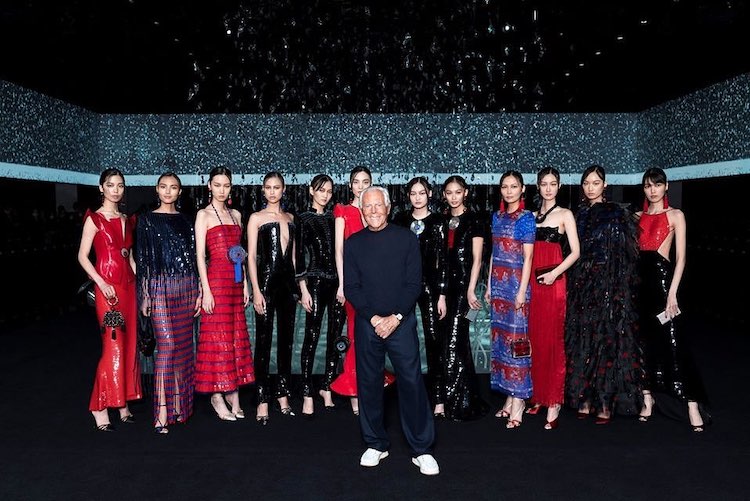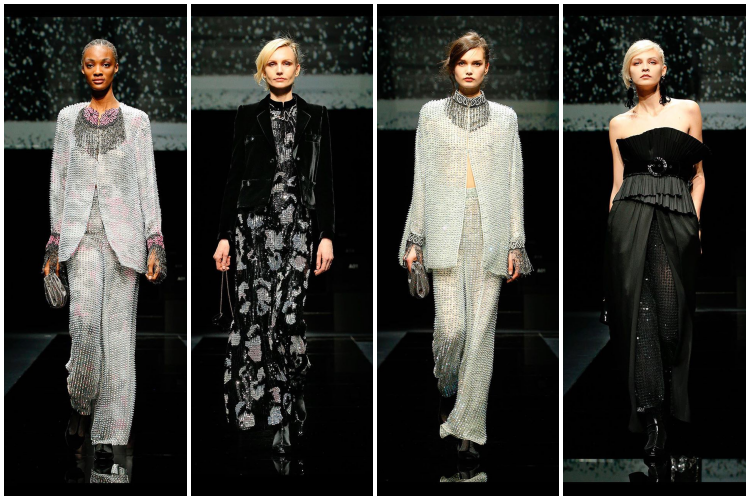The coronavirus brings with it a global economic crisis that will affect all sectors, but also an opportunity to develop a new consumption paradigm. How will the fashion industry adapt to this new situation? How do major firms foresee the future of fashion after the coronavirus?
In fashion, the need for a change in mindset, a slowing down of processes, and greater sustainability is nothing new. Experts in the sector have been calling for a more responsible industry for years. It’s a path that many brands have already begun to adopt with small or large initiatives, but now it’s truly necessary.
Donatella Versace is uncertain about the future of fashion after the pandemic, but she does know it will be different:
Many things will have to be looked at from a different perspective. Seasonality, the size of collections, how they should be… Fashion is the mirror of society; and if society changes, people’s desires will change. Designers are now searching for the right direction; perhaps fashion will be different for the better.

Donatella Versace advocates for a change in fashion for the better.
Jaume Miquel, president and CEO of Tendam, is much more assertive and says:
We’re not going back to the situation we were in; this will imply a paradigm shift. In six or twelve months, retail will transform like it hasn’t in 200 years.
Goodbye to fast fashion. Fashion after the coronavirus changes its pace.
Undoubtedly, one of the biggest changes will be in pace.
Perhaps the era of fast fashion has ended: the future world will not be one of overconsumption.
Jaume Miquel (Tendam) says. And he’s not alone. Giorgio Armani explains it practically:
It doesn’t make sense for one of my jackets or suits to be in the store for three weeks, become immediately obsolete, and be replaced by new merchandise, not too different from the previous one.

Giorgio Armani has been one of the most committed designers when talking about the future of fashion after the coronavirus.
For the designer, this is something that has to end: “I don’t want to work like this anymore; it seems immoral to me”, he said. And this applies not only to the collections that arrive in stores but also to the catwalks. Many are questioning the need for so many fashion weeks and all the economic, environmental, and creative resources invested in them. In fact, it was Giorgio Armani himself who decided to hold his fall-winter 2020-2021 fashion show in Milan behind closed doors last February.

Giorgio Armani’s fall-winter 2020-2021 fashion show was held behind closed doors.

Some of the garments that walked behind closed doors in Milan.
Selling winter clothes in winter and summer clothes in summer
For both Giorgio Armani and most designers, the most immediate consequences have been very similar. Their spring-summer 2020 collections are on hold, and with what seems like an imminent store opening, Giorgio Armani has already announced that his spring-summer designs will remain in stores at least until September this year. A highly unusual practice but one that makes a lot of sense this year.
In fact, it seems that Donatella Versace will opt for the same approach, not only this year but in the future:
To be honest, I like the idea of slowing down with the seasons; having sweaters in the shop windows in winter and swimsuits in summer.

Armani’s factories in Italy are exclusively dedicated to the manufacture of sanitary materials. The spring-summer collection is on hold.
A commitment to more sustainable fashion
But it’s not just the production rhythms that need to change, but also the way of producing, and this refers both to outsourcing and sustainability. The trend seems to be to diversify and bring production as close as possible while making it as sustainable as possible.

Stella McCartney is one of the biggest advocates of sustainability in fashion.
One of the biggest advocates about slow fashion and sustainability in recent years has undoubtedly been Stella McCartney, who perfectly sums up what she understands by the future of fashion after the coronavirus:
There will always be brands, there will always be products, you’ll always want a cup of tea, and when it breaks, you’ll buy another, or you’ll get tired of that cup and say, ‘I want a new cup, I deserve a new cup.’ That’s okay. It’s allowed, we’re allowed to consume. What we need to do is consume better. What companies need to do for the customer is do better supply better and be better brands.
But what does it mean to be a better brand? First and foremost, being more sustainable. The environmental impact of the current fashion industry is tremendous. Excessive water use, chemical pollution, CO2 emissions, and textile waste are the main problems.

The big problem of textile waste
Waste is a big, big, big problem in our industry, and I’m a big fan of trying to reduce waste or doing better with the waste that exists. I think now more than ever is the time to look at our industry and say, OK, the trucks of fast fashion that are incinerated or buried. It’s $100 billion worth of waste a year in fibers, in resources. It’s crazy.
Stella McCartney said.
Brands must approach consumers
Secondly, being a better brand means improving the relationship with the customer. It’s time to regain trust, and for that, consumers will not only look for products they like but also feel proud to wear because of the brand values they uphold. This is where sustainability plays a fundamental role, which is why sustainability and branding are intrinsically linked.
In this regard, Antoine Arnault, communications director of the LVMH group, said:
A company is not simply a financial entity that trades on the stock market: as part of the fabric of society, companies play an essential role in responding to the challenges facing society.
This crisis should also accelerate changes in consumer behavior, especially among younger generations. People will pay more attention to the environmental footprint of products, and the contribution of brands to society, and there will be a greater demand for transparency and traceability.

The LVMH group has been investing in sustainable initiatives for years. With Maison/0, they fund projects by fashion design students experimenting with new bi-responsible materials.
New needs, new solutions
But if there’s one thing that all these brands’ executives are clear about, it’s that these changes, or at least the speed at which they will be implemented, will be due to a change in consumers. The economic crisis will impact the finances of many families. Surely, we’ll all think twice about investing in a new garment. That’s why it’s so important for brands to adapt to new needs and habits.
Adaptation. A concept that Antoine Arnault (LVMH) has given great importance to when talking about the future of fashion after the coronavirus:
Adapting means being bold enough, despite everything, to pursue change, invent a model that better respects natural resources, and reaffirm one of LVMH’s most cherished values: creativity. At the end of a major past crisis, World War II, Dior invented a new look for women, and Bulgari chose the serpent, shedding its skin, as a symbol of constant reinvention for its early jewelry collections.

An immediate example of the adaptation Antoine Arnault (LVMH group) refers to is that the group’s cosmetics factories are now dedicated to producing disinfectant gel.
In summary: sustainable fashion, focusing on online and brand values
The conclusions are clear. Sustainability will be much more valued by customers, who will opt for more responsible and digital consumption. It’s the end of hyperconsumption as we know it.
A new paradigm that brands must adapt to. How? With brand communication through shop windows and experiences in physical retail and simultaneously online. An increase in online sales is expected, which is here to stay. Creating a brand, listening to consumers, and offering new services will be the foundation for understanding what customers need.
It seems that after the pandemic, many things will change, including consumption and production habits, and, above all, the way we understand fashion.
Images courtesy of the mentioned brands.
Statements extracted from WWD and the Voices for Recovery series organized by Modaes.



